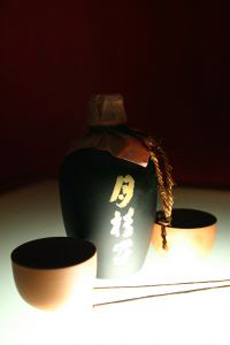Click on a letter to go to the appropriate glossary page: a b c d e f g h i j k l m n o p q r s t u v w x y z This glossary is protected by copyright and cannot be reproduced Daiginjo Saké or Daiginjoshu: Ultrapremium saké, the finest quality. Handmade, free run, small batch saké made with purified water, the finest quality rice milled to at least 50%—some are milled to 35%—and the most refined processes to create the most complex character and layers of flavor. Aged in temperature-controlled stainless steel tanks for at least nine months. Can be junmai or honjozo (alcohol added); if no alcohol is added it is labeled junmai. These delicate sakés with more gently flavored foods, such as poached whitefish or raw scallops.FLAVOR PROFILE: Fragrant, full flavors, short finish. See also ginjo and futsu. Futsu or FutsushuSaké: Ordinary saké or economy saké, made with lesser ingredients, with rice milled down only to 70% of the grain, with less complex processes, and aged 3 months or less. Typically served warm (premium saké is generally best served slightly chilled), the alcohol level can be as low as 4%. Can be junmai or honjozo. About three-quarters of all the saké produced in Japan is futsushu. See also daiginjo and ginjo. Genshu Saké: The strongest saké, genshu means “cask strength.” Also referred to as undiluted saké, as little water is added in the brewing. Thus the alcohol percentage is the highest of all sakés—18% to 21%, compared to a typical nigori saké, which has one of the higher levels of alcohol at 15%.
Honjozo Saké or Honjozoshu: Along with junmai, one of two broad categories of saké generally available in the U.S. At least 30% of the rice polished away. Honjozo differs from junmai in that a small amount of distilled alcohol has been added at the end of fermentation—generally 5% by volume. The alcohol smoothes and lightens the flavor and makes the fragrance more prominent. There are sakés that have a higher percentage of added alcohol than honjozo sakés, but they are almost never imported into the United States. In Japan, about 88% of all sakés are honjozo. For average sakés, the distilled alcohol is usually processed grain alcohol. Finer sakés may use distilled alcohol collected from the esters during fermentation, which enhance the aroma. FLAVOR PROFILE: Fragrant, earthy, long finish. See also junmai. Continue To Next Page: Terms I Through K
|

The Nibble Blog
The Latest Products, Recipes & Trends In Specialty Foods
The gourmet guide you’ve been waiting for. New food adventures are served up daily. Check it out!

Food Glossary
Our Food Directories Are "Crash Courses" In Tasty Topics
Your ultimate food lover’s dictionary packed full of information and historical references. Take a look!

Food History
Let the journey begin!
Learn about the history Of 1,000+ Favorite Foods & Beverages Let’s explore the history of your favorie goods together.Let the journey begin!


